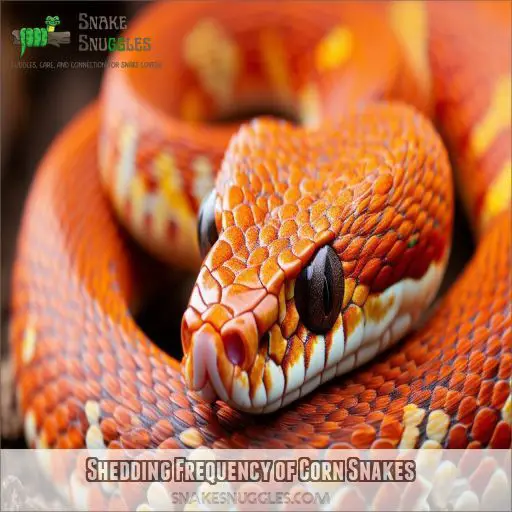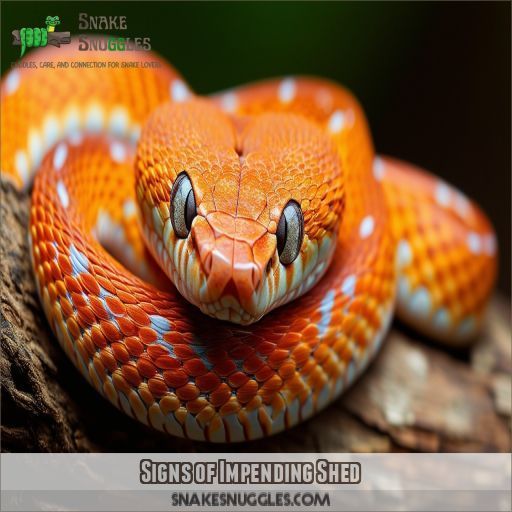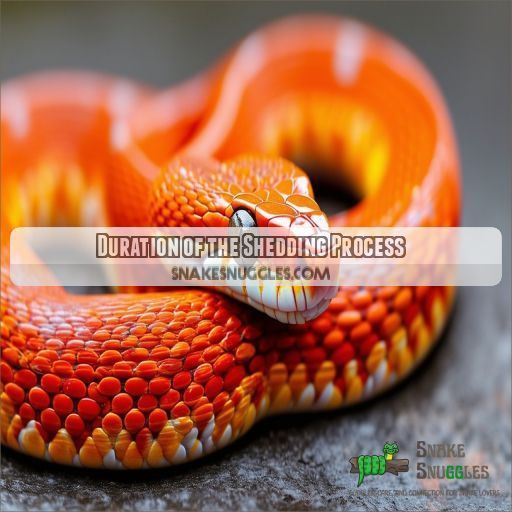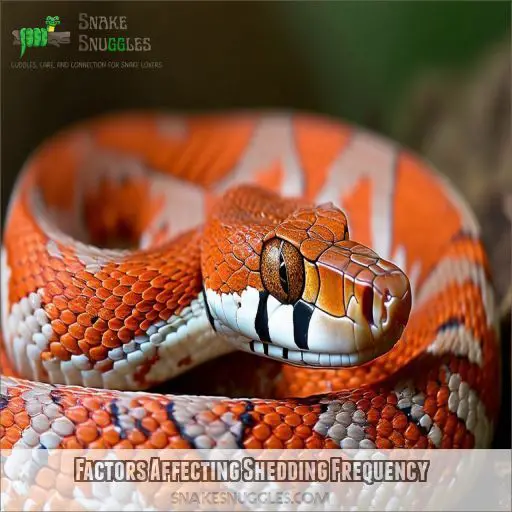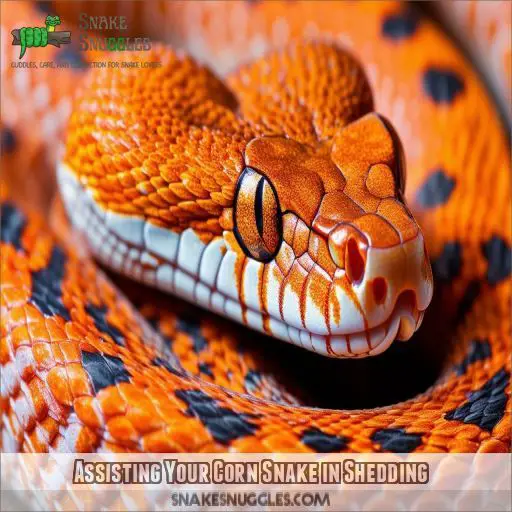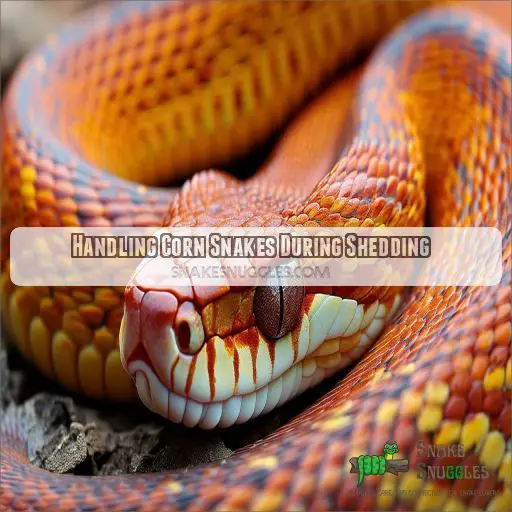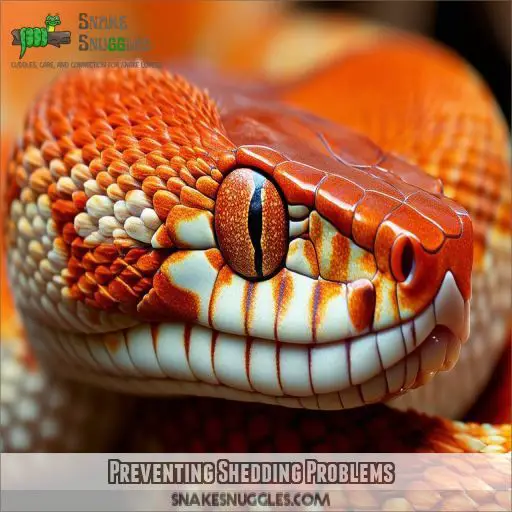This site is supported by our readers. We may earn a commission, at no cost to you, if you purchase through links.
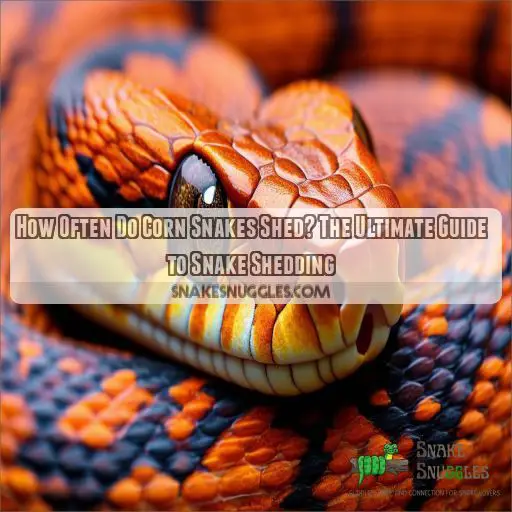 Have you ever wondered how often your corn snake sheds its skin? As a corn snake owner, understanding the shedding process is critical for your pet’s health.
Have you ever wondered how often your corn snake sheds its skin? As a corn snake owner, understanding the shedding process is critical for your pet’s health.
Corn snakes typically shed every 4-8 weeks, but this can vary based on age, growth rate, and environmental factors.
Recognizing the signs of impending shed and providing proper care during this time ensures your snake’s comfort and well-being.
This guide will explore the intricacies of corn snake shedding, helping you master this essential aspect of reptile care.
Table Of Contents
- Key Takeaways
- How Often Do Corn Snakes Shed Their Skin?
- Shedding Frequency of Corn Snakes
- Signs of Impending Shed
- Duration of the Shedding Process
- Factors Affecting Shedding Frequency
- Assisting Your Corn Snake in Shedding
- Handling Corn Snakes During Shedding
- Preventing Shedding Problems
- Frequently Asked Questions (FAQs)
- Is it OK to hold my corn snake while its shedding?
- How long does it take for a corn snake to shed its skin?
- Why is my adult corn snake shedding so much?
- How often does a 2 year old corn snake shed?
- Can corn snakes eat their shed skin?
- How does a snakes age affect shedding color?
- Do different color morphs shed at different rates?
- Can shedding indicate health issues in corn snakes?
- How does breeding affect a corn snakes shedding cycle?
- Conclusion
Key Takeaways
- Corn snakes are shedding superstars, slipping out of their old skin every 4-8 weeks – talk about a wardrobe refresh!
- Keep your eyes peeled for the telltale signs of an impending shed: dull scales, cloudy eyes, and a snake that’s suddenly playing hard to get.
- Creating the perfect shedding spa day for your scaly friend is key – think warm baths, humidity havens, and some rough-and-tumble décor to help them slip out of that old skin.
- When it comes to handling during shedding, less is more. Let your corn snake have its beauty rest – after all, you wouldn’t want someone poking you while you’re trying on a new outfit!
How Often Do Corn Snakes Shed Their Skin?
Corn snakes typically shed their skin every 4-6 weeks as juveniles and every 3 months as adults. However, how often corn snakes shed their skin can vary based on factors like age, health, and environment.
You’ll notice signs of impending shed, such as dull scales and cloudy eyes, about a week before it happens. The shedding process itself usually takes around a week.
To help your scaly friend, maintain proper humidity levels and provide abrasive surfaces for rubbing. If shedding lasts longer than 10 days or you notice retained shed, consult a vet.
There’s more to learn about this fascinating process that keeps your corn snake looking fresh and fabulous.
Shedding Frequency of Corn Snakes
As a corn snake owner, you’ll quickly become familiar with their shedding process, which is a natural part of their growth and development. The shedding frequency of corn snakes varies depending on their age, with younger snakes shedding more frequently than adults. Juvenile corn snakes typically shed every 4-6 weeks, while adults slow down to shedding every 3 months or so.
However, there are other factors that can influence shedding frequency. For example, if your snake is dealing with parasite issues, you might notice an increase in the number of sheds. Similarly, female corn snakes may shed more frequently before or after giving birth.
During the shedding process, it’s important to be mindful of a few handling considerations. Your corn snake’s skin will be more delicate, and they may become irritable, so it’s best to avoid handling them during this time.
Signs of Impending Shed
As your corn snake approaches shedding, you’ll notice its scales become dull and pale, and its eyes turn cloudy or milky. Other signs include sagging skin on the chin and neck, increased hiding, and a reduced appetite.
Dull and Pale Scales
As a snake owner, you’ll want to keep a close eye on the subtle changes in your pet’s scale appearance, especially during shedding.
A telltale sign that your corn snake is getting ready to shed is a change in the appearance of its scales, which will start to look dull and pale.
This skin dullness and pale coloration are natural parts of the shedding process, indicating that your snake is preparing to shed its old skin.
Cloudy or Milky Eyes
Another telltale sign that your corn snake is getting ready to shed is a change in their eye appearance. Their eyes may become cloudy or milky, and you may notice a bluish or greenish tint. This is due to temporary corneal clouding, which affects their vision.
Keep an eye out for any discharge or signs of infection, and consult your veterinarian if you have any concerns about your snake’s eye health during this time.
Sagging Skin on Chin and Neck
As a sign of impending shedding, you may notice that your corn snake’s skin on its chin and neck appears to be sagging. This is a normal part of the shedding process and isn’t cause for concern. It’s simply an indication that your snake is preparing to shed its skin.
This skin loosening is more noticeable in older snakes, as the skin becomes less elastic with age. Additionally, proper nutrition plays a role in the health of a snake’s skin, so make certain your snake is receiving a balanced diet.
Increased Hiding
As your corn snake prepares for shedding, you may observe it spending more time in its hideout box or seeking refuge in hiding logs.
This behavior is a natural reaction to the stress of shedding.
Your snake is instinctively seeking security and protection during this sensitive period.
To accommodate its needs, ensure that your enclosure is sufficiently spacious, offering ample room for your snake to explore and locate a cozy hiding place.
Maintain a stress-free environment by employing gentle handling practices and upholding a clean habitat for your pet.
Reduced Appetite
A Sign of Impending Shed
As a responsible corn snake owner, it’s important to be aware of the various signs that indicate your snake is about to shed its skin. One of these signs is a decrease in appetite. Here’s what you need to keep in mind:
- Diet and Nutrition: During the shedding process, your corn snake’s appetite may decrease. This is a normal shedding behavior, and you shouldn’t be too concerned if they eat less during this time.
- Stress and Comfort: Make sure your snake’s shedding environment is comfortable and stress-free. A calm and relaxed snake is more likely to eat when offered food.
- Feeding Schedule: While their appetite may be reduced, continue to offer food at regular intervals. This will help ensure they get the necessary nutrition and maintain a healthy diet.
- Consult a Vet: If your corn snake’s reduced appetite persists for an extended period or if you have other concerns about their health, don’t hesitate to consult a reptile veterinarian for professional advice.
Duration of the Shedding Process
The shedding process itself is a fascinating transformation. Your corn snake will undergo a remarkable renewal, sloughing off its old skin to reveal a fresh, new layer. This natural process typically takes around a week to complete, but it can vary depending on various factors.
During shedding, your snake becomes a master of moisture absorption and skin friction. It secretes moisture to loosen the old skin, creating a whitish sheen. Alternatively, it might seek out warm water and higher humidity to achieve the same effect. Either way, the moisture softens the old skin, making it easier to remove. Your snake then uses friction by rubbing against surfaces to shed the loose skin, a process that can take a few days.
You’ll notice the scale appearance change as the old skin comes off. The new skin underneath is vibrant and shiny, enhancing your snake’s color and pattern. This process is essential for your snake’s health and growth, ensuring it can breathe, move, and regulate its body temperature effectively.
Factors Affecting Shedding Frequency
The frequency of shedding in corn snakes can vary depending on their age. Factors like parasite issues or pregnancy and birth can also impact how often a corn snake sheds its skin.
Age of the Snake
The age of your corn snake plays a significant role in how often it sheds. Juvenile corn snakes shed more frequently, about every 4-6 weeks, as their growth rate is faster. As they mature, their shedding frequency decreases to about once every 3 months.
- Age: Younger snakes shed more often than adults.
- Diet: A healthy diet provides necessary nutrients for proper shedding.
- Health: Overall health impacts shedding.
- Environment: Proper humidity levels and warm water baths assist shedding.
Parasite Issues
Parasites are another factor that can influence shedding frequency. A parasitic infection can cause your snake to shed more frequently. This is because parasites irritate the skin and shedding provides temporary relief. However, it’s crucial to recognize that frequent parasitic shedding can lead to health issues. If you suspect a parasitic infection, it’s advisable to consult a veterinarian.
Pregnancy and Birth
Pregnancy and birth can influence shedding frequency in corn snakes. Here are some key factors to keep in mind:
- Gestation Period and Egg Development: The gestation period varies among species, and it influences the timing of birth and subsequent shedding patterns.
- Maternal Care: During pregnancy, female snakes may experience increased shedding as their bodies prepare for birth and maternal duties.
- Post-Birth Behavior: After giving birth, shedding may increase as the snake’s body recovers from the birthing process and adjusts to motherhood.
- Offspring Size and Development: Larger offspring may require more frequent shedding as they grow, while smaller offspring may shed less frequently.
Assisting Your Corn Snake in Shedding
Assisting your corn snake in shedding involves maintaining proper humidity levels, providing warm water for bathing, and adding abrasive materials to their enclosure. Ensuring a healthy diet and consulting a vet if needed can also support a smooth shedding process.
Proper Humidity Levels
Maintaining appropriate humidity is paramount for your corn snake’s shedding process. Aim for a humidity level between 40-60%, utilizing a hygrometer to monitor it accurately.
Create a humidity gradient by spraying one side of the enclosure or providing a humidity shelter. Use a 3% bleach solution to clean humidity sources consistently.
A well-balanced environment will assist your scaly companion in shedding effectively, ensuring a seamless transformation from old to new skin.
Warm Water Bathing
Beyond maintaining proper humidity, warm water bathing can help your corn snake shed more easily. Here’s how to do it effectively:
- Fill a shallow tub with warm water (85-90°F)
- Place your snake in for 10-15 minutes
- Verify that the water level allows your snake to keep its head above water
- Repeat daily during shedding, if needed
This process softens the old skin, making it easier to remove. Always supervise your snake during bathing to guarantee its safety.
Abrasive Materials in Enclosure
After providing a warm bath, it’s essential to provide your corn snake abrasive materials in its enclosure. These shedding aids help your snake rub against surfaces to remove old skin. Here’s a quick guide to suitable materials:
| Material | Shedding Benefit | Moisture Retention | Recommended Use |
|---|---|---|---|
| Aspen | Low abrasion | Low |
Healthy Diet
A healthy diet is essential for your corn snake’s shedding process. Offer appropriately sized frozen rodents using feeding tongs to maintain proper nutrition. Guarantee regular feeding sessions and provide supplements if needed.
A well-balanced diet rich in vitamins supports digestive health and skin renewal. Always use a screened lid to prevent escape during meals.
Consulting a Vet
While a healthy diet supports shedding, there are times when you’ll need expert help. If your corn snake’s shedding process lasts longer than 10 days or you notice retained shed, it’s time to consult a vet. They can provide:
- Treatments for retained shed, including safe removal techniques
- Advice on potential health risks associated with shedding issues
- Recommendations for adjusting your snake’s habitat, such as under-tank heaters or UV fixtures
Don’t hesitate to seek professional help for your scaly friend‘s well-being.
Handling Corn Snakes During Shedding
During shedding, your corn snake’s comfort and safety should be your top priority. It’s best to minimize handling, as your snake may feel more vulnerable and stressed. If you must handle your snake, do so gently and for short periods. Be extra cautious around the eyes, which are sensitive during this time. To prevent bites, approach your snake slowly and avoid startling it.
Keep your snake’s habitat secure and maintain proper temperature using a reliable thermostat. Provide plenty of hideaway boxes and climbing décor to help your snake feel safe. These features also assist in the shedding process by allowing your snake to rub against surfaces.
Preventing Shedding Problems
To prevent shedding problems in your corn snake, focus on creating a suitable environment. Maintain appropriate humidity levels in the terrarium by using a hygrometer and misting regularly. Avoid overfeeding, as excess weight can lead to difficult sheds. Provide abrasive surfaces like rough bark or terrarium backgrounds for your snake to rub against, helping remove loose skin.
Here are three key strategies to guarantee successful shedding:
- Incorporate plants and sphagnum moss to boost humidity naturally
- Install proper lighting to regulate temperature and aid in shedding
- Offer a "humidity hide" filled with damp moss for additional moisture
Frequently Asked Questions (FAQs)
Is it OK to hold my corn snake while its shedding?
It’s best to avoid handling your corn snake while it’s shedding. You’ll stress it out and might damage its new skin. Wait until the process is complete, usually within a week, before resuming normal handling.
How long does it take for a corn snake to shed its skin?
Like a serpentine butterfly emerging from its chrysalis, your corn snake’s shedding process typically lasts 7-14 days. You’ll notice cloudy eyes and dull scales as it begins, culminating in the dramatic reveal of a fresh, vibrant coat.
Why is my adult corn snake shedding so much?
If your adult corn snake‘s shedding frequently, it might be due to parasites, stress, or environmental factors. Check humidity levels, diet, and overall health. Consult a vet if shedding occurs more than every 3 months or seems problematic.
How often does a 2 year old corn snake shed?
Your 2-year-old corn snake typically sheds every 2-3 months. As an adult, it’s shedding less frequently than when it was a juvenile. Keep an eye out for signs like dull scales and cloudy eyes to anticipate the next shed.
Can corn snakes eat their shed skin?
Like a snake shedding its past, corn snakes don’t typically eat their shed skin. You’ll want to remove it from their enclosure. It’s not nutritious for them and could harbor bacteria. Keep their habitat clean and healthy.
How does a snakes age affect shedding color?
As your snake ages, you’ll notice its shedding color changes. Younger snakes often have brighter, more vibrant sheds, while older ones may produce duller, less colorful skins. This reflects the natural aging process of their scales.
Do different color morphs shed at different rates?
Color morphs don’t typically affect shedding rates in corn snakes. You’ll find that age, health, and environmental factors play a bigger role. Young snakes shed more frequently, while adults shed every few months, regardless of their color pattern.
Can shedding indicate health issues in corn snakes?
Abnormal shedding in corn snakes can be a symptom of various health issues, such as skin infections caused by bacteria or poor habitat conditions. Yes, abnormal shedding can signal health problems in corn snakes. Watch for incomplete sheds, retained eyecaps, or frequent shedding. These may indicate issues like mites, poor nutrition, or incorrect humidity levels. Consult a reptile vet if you’re concerned.
How does breeding affect a corn snakes shedding cycle?
Like Aphrodite emerging anew, breeding corn snakes shed more frequently. You’ll notice females shedding before and after laying eggs. Males may shed more during mating season. This increased shedding supports reproductive health and egg production.
Conclusion
Mastering the art of corn snake shedding is essential for every reptile enthusiast!
By understanding how often corn snakes shed their skin and recognizing the signs, you’ll become a shedding expert in no time. Remember, proper care during this process is important for your snake’s health.
With the right humidity, diet, and environment, you’ll guarantee smooth shedding cycles. Always monitor your corn snake closely and consult a vet if issues arise.
Armed with this knowledge, you’re well-equipped to provide excellent care for your scaly friend throughout its shedding journey.

